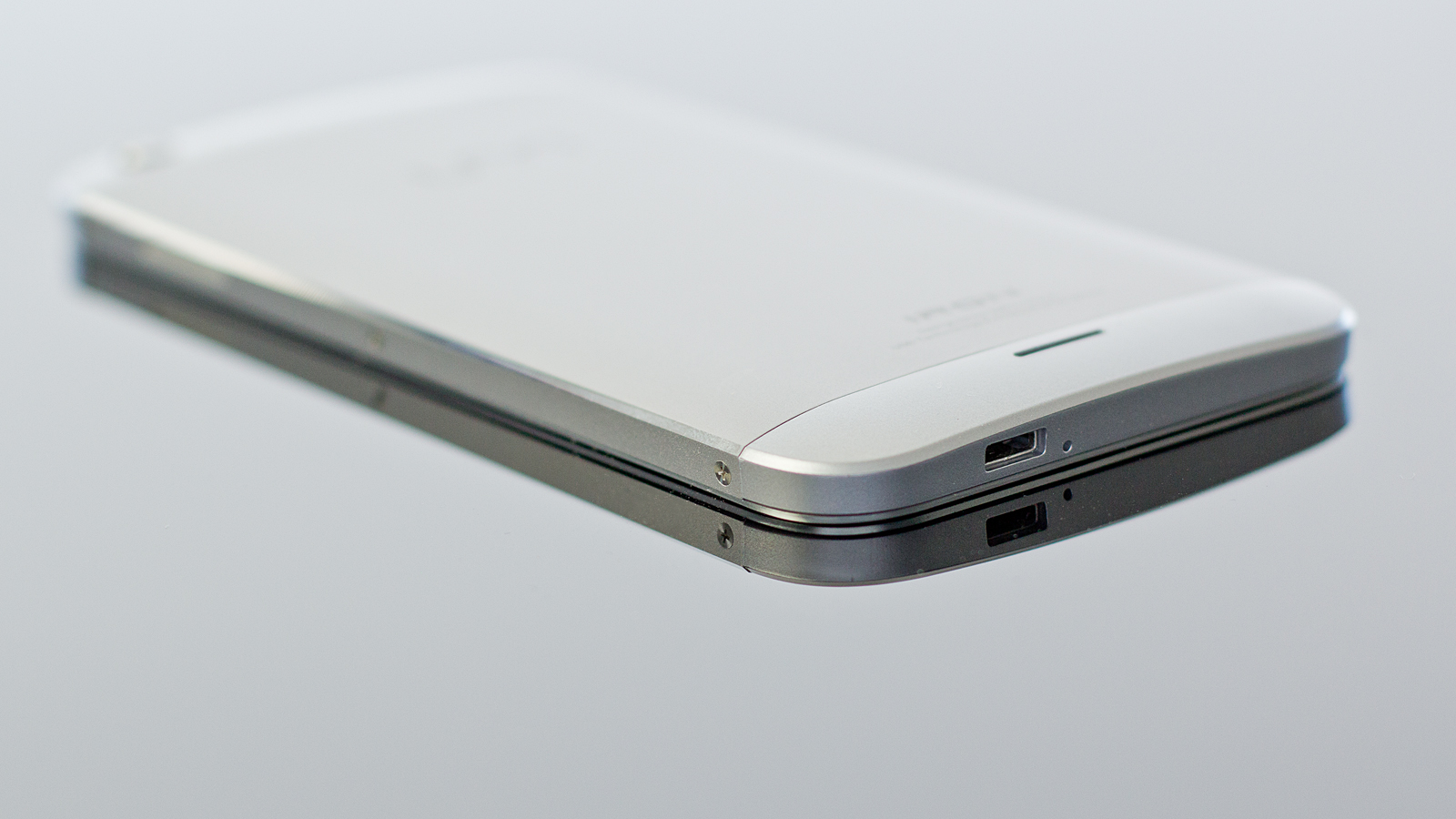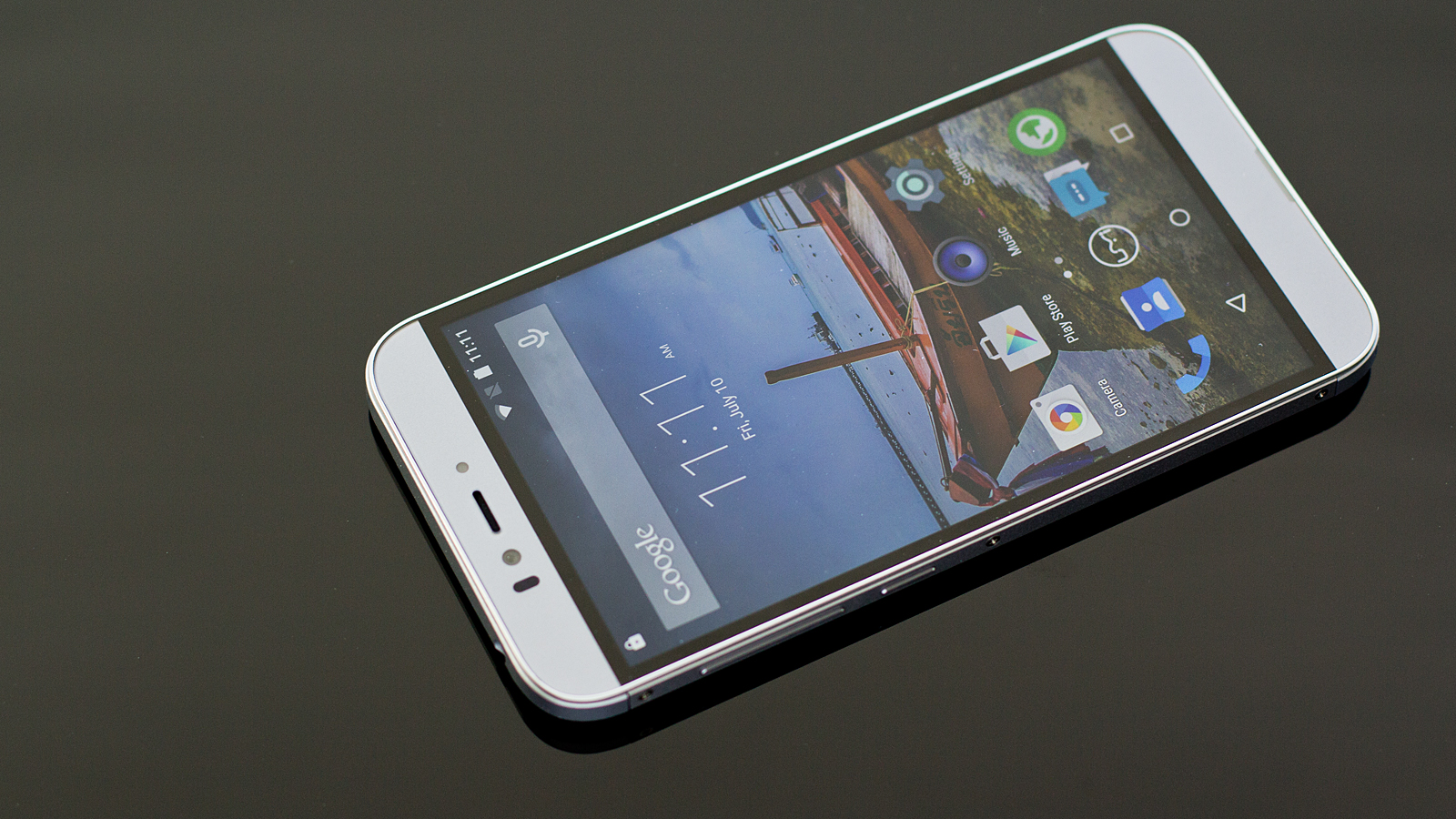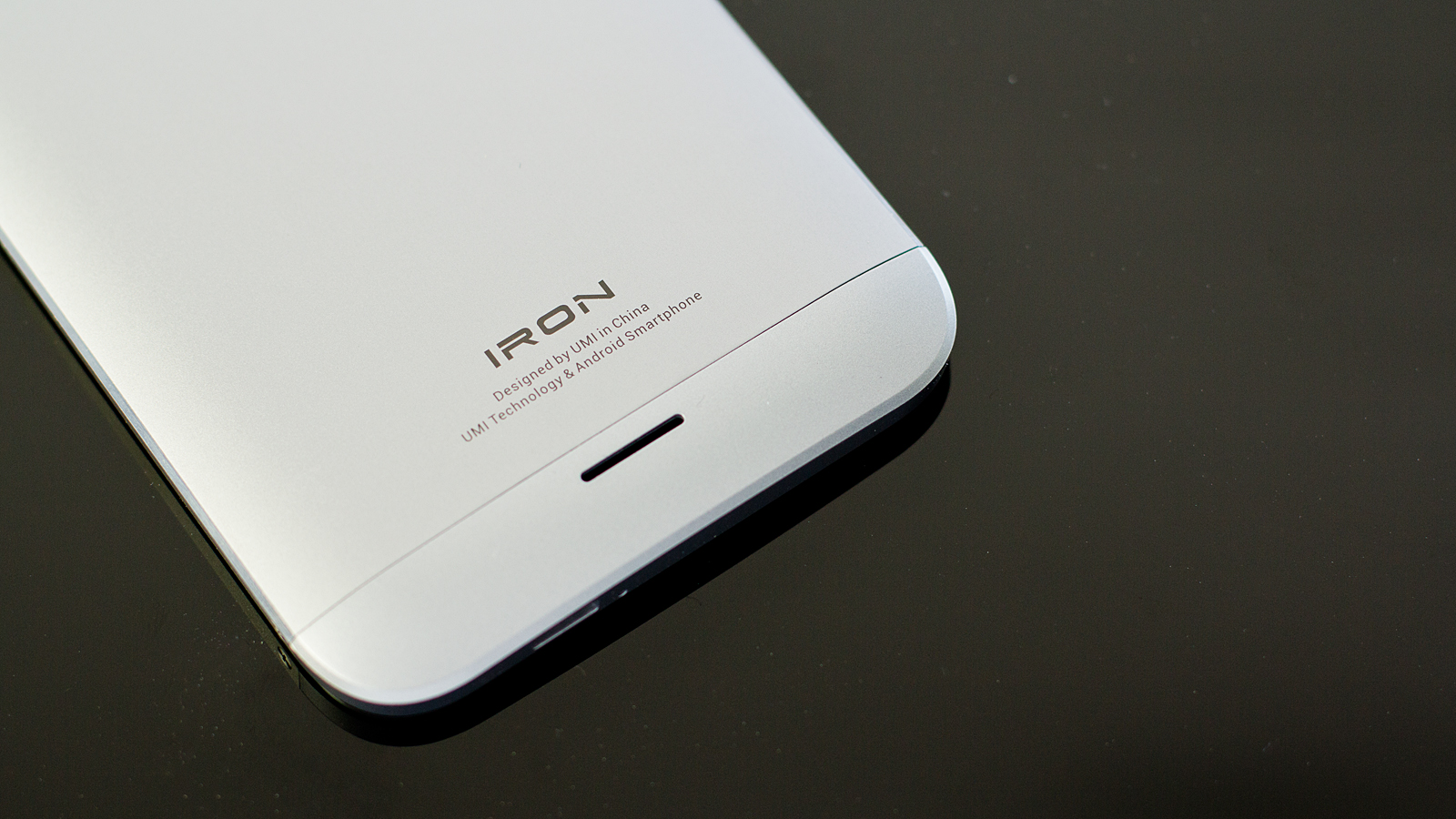The Eyeverify system scans the unique vein pattern and precise positioning of your pupils to make a match, and the optional setting that requires you to blink during verification tightens security by ensuring the Iron must be faced with a living, breathing human rather than a cleverly angled photo. It sounds great, but the ability to bypass the eye verification with a four-digit passcode is a chink in its otherwise impenetrable armour. The UMI Iron is a phablet with a 5.5in full-HD screen. With an all-metal build it looks good – something of a mash-up between an iPhone, an HTC and a Samsung Galaxy – and it feels reassuringly tough. There are some nice extra touches such as the customisable pulse notification light at the base of the screen, too. Highlights in its specification include an octa-core, 64-bit MediaTek MTK6753 processor running at 1.3GHz, 3GB of RAM, 16GB of storage and the ability to either bolster this capacity with an additional 64GB, or add dual-SIM support with both cards capable of handling mobile data. Performance is good, making this UMI phone a great all-rounder at an even better price. See all smartphone reviews. There’s an 8Mp selfie camera at the front of the Iron, plus what UMI claims is the world’s leading 13Mp camera at the back – Sony’s IMX214 is a six-lens, f/2.0 snapper that does an admirable job in all conditions. There’s an LED flash front and rear, too. In common with the Samsung Galaxy S6 the UMI Iron has a heart-rate scanner that also purports to measure stress, here found on the front of the device to the left of the camera. However, although our review sample was running the latest software, we weren’t able to get this to work. The Iron comes with Android Lollipop preinstalled, but UMI Rootjoy support makes it easy to plug in the Iron to a PC and load up MIUI or an OS of your choice. Stick with the out-of-the-box OS and you’ll benefit from useful screen gestures and a slim OS with very little bloat. Also see: Best Android phones 2015.
UMI Iron review: Price and UK availability
Our UMI Iron was supplied with black and white flip covers, plus a Magic Glass tempered glass screen protector. These optional extras are available from Geekbuying for £7.81 and £6.51 respectively. Also see: Best MiFi 2016.
UMI Iron review: Design and build
The UMI Iron is a good-looking phone. It’s something of a cross between an HTC, Samsung Galaxy and iPhone 6 Plus, with a large 5.5in screen, all metal build and a rounded slab-like design with a gently curved rear. This phablet is rather large, thanks to the 5.5in screen, but not unweildy, just 148g and 7.9mm thick. Also see: Best budget phones 2015. It feels durable, CNC milled with metal buttons, metal screws… metal everything save for the screen. This panel is a full-HD (1920×1080) LTPS panel, which is good news for battery life. It’s good news for consumers, too, and its 403ppi pixel density makes for clear text and images, free from any signs of fuzziness. Colours are vivid and the screen usefully bright. We like the pulse notification light at the base of the screen, which helps to ensure you never miss a call or text. The colour of this pulse light is customisable, too. Also see: Best Chinese phones 2015. The only hardware buttons on the UMI Iron are a volume rocker and power switch on its left edge; on the right is a dual-SIM tray that can either support two Nano-SIMs (both connected to Vodafone’s 3G network in our tests) or one SIM and a microSD card up to 64GB. The rear cover isn’t removable, which means neither is the 3350mAh battery inside. A headphone jack is found on the UMI Iron’s top edge, and on the rear a 13Mp camera protrudes slightly. This is protected with stainless steel, and paired with a dual-LED flash. At the front of the device you’ll find an 8Mp webcam, also with an LED flash, which can not only take great selfies but is critical to the UMI’s eye-scanning security. We have two main gripes with the Iron’s build, although both may be down to a fault with our early handset rather than anything to cause concern. Despite checking we were running the latest software, we couldn’t get the heart-rate scanner (located to the left of the selfie camera) to work. And the Micro-USB charging port at the bottom of the device is oddly square in shape, making it difficult to connect a cable. It actually got our hopes up for a minute that it could be USB Type-C but, sadly, no. Also see: Best smartphones 2015.
UMI Iron review: Hardware and performance
The UMI Iron might have a cheap price tag, but it has some fairly decent hardware inside. Combining a 1.3GHz MediaTek MTK6753 64-bit octa-core chip with 3GB of RAM and Mali T720 graphics, performance is good – if some way off the best we’ve seen. In real-world use there’s little sign of lag when launching apps and navigating menus, which is more important than benchmark performance of course. Nevertheless, we did run the UMI through our usual speed tests. First we ran Geekbench 3.0, which measures overall processing speed. With a multi-core score of 2606 points, the UMI Iron falls a little below 2014 flagships such as the Samsung Galaxy S5 (2869), Sony Xperia Z3 (2805), Nexus 5 (2800) and HTC One M8 (2761). Its brother, the UMI eMax, managed a much faster score with 4101 points. SunSpider web-browsing performance wasn’t brilliant, although we have seen worse. Measuring 1552ms the UMI Iron is in line with the OnePlus 2 (1471ms), Moto G 2014 (1504ms), Vodafone Smart Ultra 6 (1545ms) and Sony Xperia M2 (1647ms). We also ran the UMI Iron through AnTuTu, in which it recorded 32,873 points and fell roughly in line with its other brother the UMI Hammer (32,506), although it failed to run our GFXBench graphics tests. You can compare the UMI Iron’s performance to all the phones we’ve recently tested in our article What’s the fastest smartphone 2015. The 3350mAh battery inside should be good for a full day’s use, although we should point out that it doesn’t build in support for wireless- or quick charging, nor are there any special battery-saving modes.
UMI Iron review: Connectivity and extras
The key selling point of the UMI Iron is its Eyeverify security. This is the first time we’ve seen it on a smartphone, and it’s undeniably cool. But it’s not any more secure than any other type of biometric security, such as a fingerprint scanner, given that you can bypass it and enter a four-digit PIN. So, it’s as secure as that four-digit PIN. For what it’s worth, though, the eye scanner works very well – even if you’re wearing contacts. It scans the unique vein pattern in your eyes and exact positioning of your pupils to make a match, and can even do so at night or in dim light by adjusting the screen brightness. Because it uses the camera rather than an infra-red or other scanner, doing so won’t harm your eyes. The UMI Iron recognised our eyes every time we tried to access it, and the same can’t always be said for fingerprint scanners. It’s marginally slower to unlock the phone than inputting a PIN, but we like the fact you can force it to require a blink before it’ll accept your ‘eyeprint’ – preventing anyone being able to unlock the phone with a photo of your face. We mentioned the heart-rate scanner in our introduction, which unfortunately failed to work on our review sample. For some users it’ll prove a nice extra for helping them (or maybe just reminding them) to keep an eye on their health, but we have one on our Samsung Galaxy S6 and have to admit to very rarely using it. Still, it’s a nice extra – if you can get it to work. Another extra is the Texas Instruments Directpath audio technology, which has an industry-leading signal-to-noise ratio of 127dB. A Maxx EQ app lets you fine-tune audio settings to your taste. The Iron’s speaker is found on the device’s rear, but the size of the phone stops it getting muffled by your palm. The UMI Iron is a dual-SIM phone but, in common with the UMI Zero, you must choose between dual-SIM and microSD support. If you think the device’s 16GB of storage won’t be enough for your needs, then you’ll appreciate being able to add up to 64GB via MicroSD. Also see: How to add storage to Android. In our tests both Nano-SIM slots on this dual-standby phone worked on Vodafone’s 3G network (the UMI Iron is actually a 4G phone where you are in range). Also see: Best dual-SIM phones. If you are buying the UMI Iron for use in the UK you should ensure it is supported by your mobile network operator. Supported frequencies are as follows: 2G: GSM 900/1800/1900MHz, 3G: WCDMA 900/1900MHz/2100MHz, 4G: FDD-LTE 1800/2100MHz/2600MHz. Also see: How to check whether a phone is supported by your network. The UMI Iron has support for HotKnot, which is MediaTek’s answer to NFC. With Android Pay soon to launch we’d rather see NFC, but we get the impression that HotKnot is a bigger deal in China. Also see: What is NFC? Other connectivity specs are relatively standard. There’s GPS and A-GPS, support for Bluetooth 4.0 and 802.11b/g/n (neither are the latest standards), plus Wi-Fi Hotspot and OTG.
UMI Iron review: Cameras
UMI says the Iron features the world’s leading 13Mp camera. It’s a Sony IMX214 camera with six precision lenses, a blue glass filter, f/2.0 aperture and dual-LED flash. The full 13Mp is available only in 4:3, otherwise the UMI Iron tops out at 9.5Mp in 16:9 mode. Also see: Best phone camera 2015. Some detail is lacking, but we were reasonably impressed with it when faced with the proposition of a dreary, overcast central London photoshoot. All the usual modes are available, including HDR, Panorama, Live Photo and Motion-Tracking. You can also get real-time previews of various filters. We’re more impressed by the front camera, though. With 8Mp to hand this f/2.2 front camera on paper should be better than the rear camera of many phones at the same price point. Except in our tests we couldn’t see how to actually get anything more than 5Mp from it – and that was in 4:3 mode; in 16:9 we could achieve only 4Mp. You can toggle on a beauty mode and ramp up settings for wrinkle removal and, as with most Chinese phones we review, face whitening. It also supports gesture shot and voice capture.
UMI Iron review: Software
The UMI Iron runs Android 5.1 Lollipop out of the box, but support for Rootjoy means you can plug it into a PC or laptop and relatively quickly and easily install a new OS, including the likes of Xiaomi’s MIUI. Rootjoy can also be used for backup purposes. The softare will be familiar to existing Android users, with few additions to the standard Lollipop OS. UMI has added a handful of apps, plus support for double-tap to wake and the aforementioned Pulse notification light. You can also configure a Guest user account. Follow Marie Brewis on Twitter. Marie is Editor in Chief of Tech Advisor and Macworld. A Journalism graduate from the London College of Printing, she’s worked in tech media for more than 17 years, managing our English language, French and Spanish consumer editorial teams and leading on content strategy through Foundry’s transition from print, to digital, to online - and beyond.






